THE ATLANTIC PORTUGUESE DIET
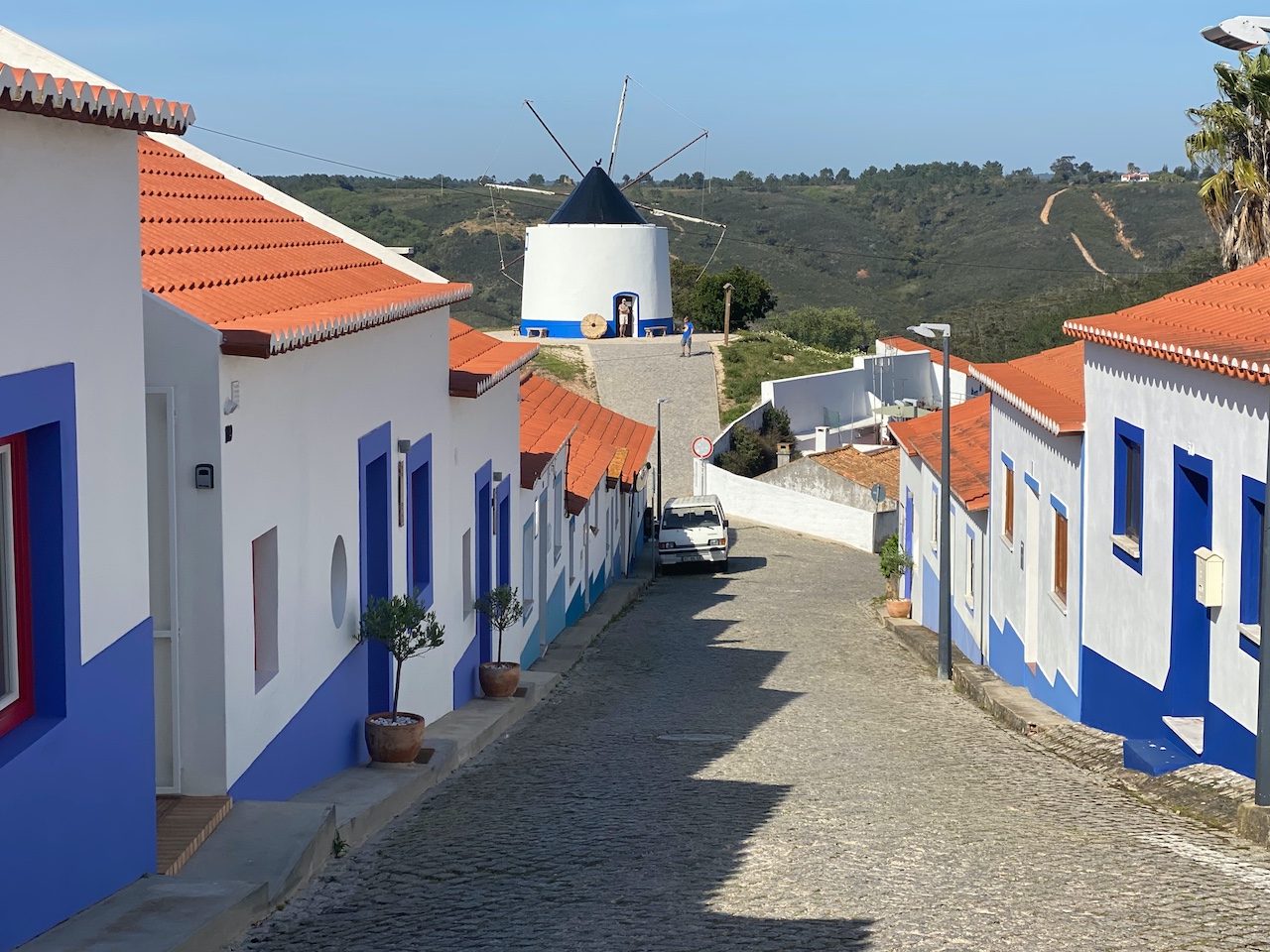
Looking into the most popular Portuguese foods it’s easy to associate the traditional cuisine of Portugal with the Atlantic diet. The Portuguese Atlantic diet has elements in common with the more well known Mediterranean diet, but it is more defining for Portuguese food ingredients and eating habits today than the Mediterranean one.
Thanks to the close proximity of the Southern Atlantic and the Mediterranean, both these diets have elements in common, but we’d like to explore their differences to best understand how they’ve shaped the culinary heritage of Portugal. Furthermore, it’s curious to understand why we don’t hear all that much about the Atlantic diet as a firm concept, when it indeed represents so well our food and lifestyle habits.
 As a matter of fact, most people may think that Portugal follows the much praised Mediterranean diet. Since 2010 UNESCO has classified the Mediterranean diet as Intangible Cultural Heritage, first encompassing Spain, Italy, Greece and Morocco. In 2013, UNESCO also included Portugal, Cyprus and Croatia as key countries shaping the patterns of this diet, so it wouldn’t be wrong to assume that Portuguese eating habits do indeed fall under the category of the Mediterranean diet. But this may just not be the complete picture…
As a matter of fact, most people may think that Portugal follows the much praised Mediterranean diet. Since 2010 UNESCO has classified the Mediterranean diet as Intangible Cultural Heritage, first encompassing Spain, Italy, Greece and Morocco. In 2013, UNESCO also included Portugal, Cyprus and Croatia as key countries shaping the patterns of this diet, so it wouldn’t be wrong to assume that Portuguese eating habits do indeed fall under the category of the Mediterranean diet. But this may just not be the complete picture…
Looking into some of the recognizable characteristics of the Mediterranean diet, we could be quick to assume that Portugal follows its eating patterns and lifestyle. But, as mentioned above, it isn’t as straightforward as that. In recent years, scientist have not only been researching the potential of the Atlantic diet, they have also been writing about this concept, breaking it down into solid principles which are representative of most of Portugal’s and also part of Spain’s food habits and which are now better helping us to understand what the Atlantic way of producing food and eating is all about.
If Portugal shares about 150 km (aprox. 95 miles) with the Mediterranean sea, it also has 832 km (517 miles) of its shoreline in direct contact with the Atlantic ocean, and this certainly has tremendous potential to influence our sources of food and eating habits, as we’re about to see next, while making the case that defends that the predominant diet in Portugal is indeed the Atlantic diet!
Portuguese Atlantic Diet
The Southern European Atlantic diet in Portugal
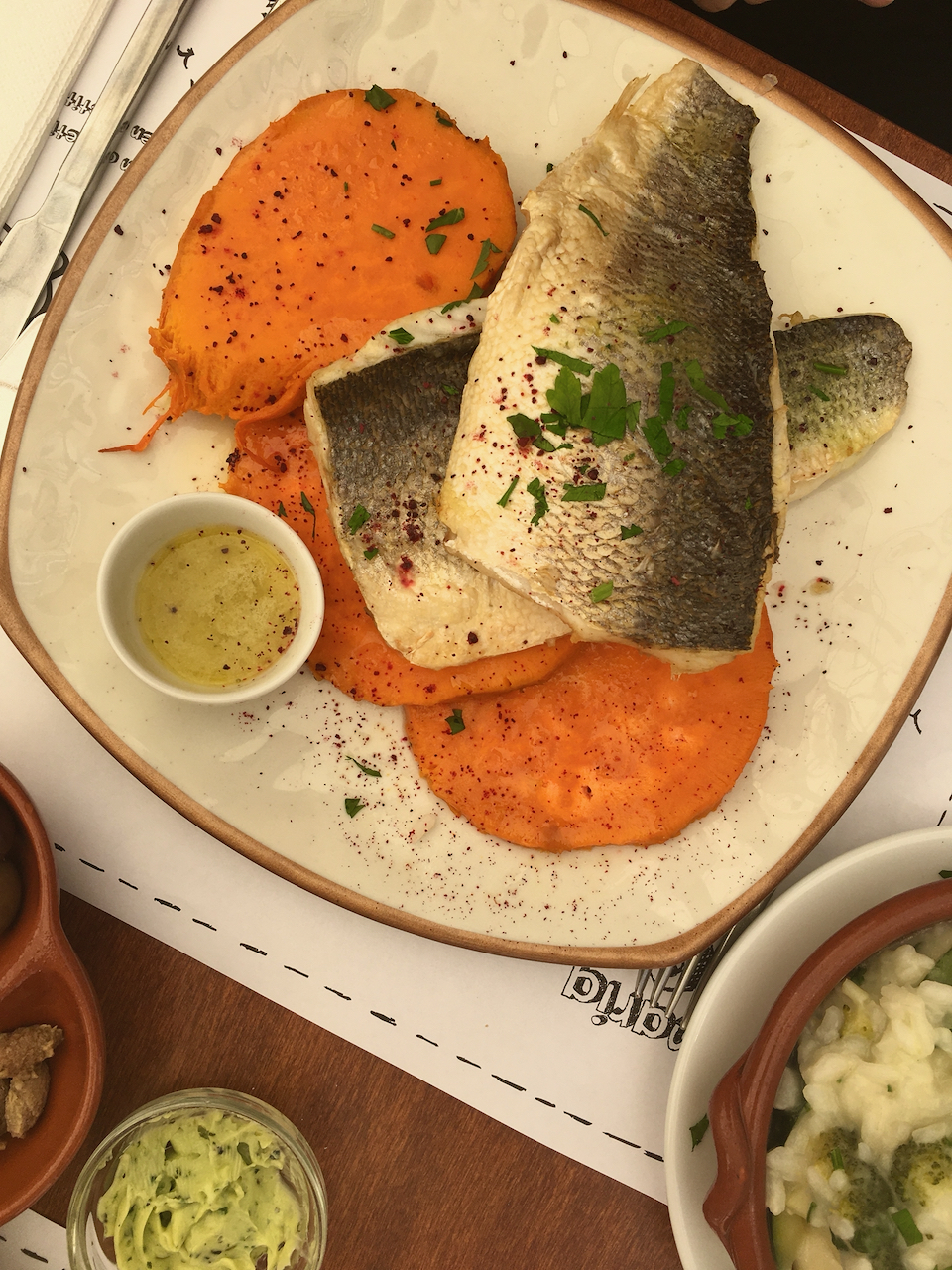
Lunch at Maria Catita restaurant
The Southern European Atlantic Diet (known in short as SEAD) is the traditional dietary pattern of most of Portugal, particularly the north, and also north-western Spain, namely in the Galicia region of our neighboring country. It could be argued that the Atlantic diet is Portugal’s traditional diet, as it is closely linked with the vast majority of the Portuguese territory and the food growing habits and culinary traditions we can observe in most regions of our country.
The concept of the Atlantic diet only came about in a more formal way in the last couple of decades, when Portuguese and Spanish scientists came together to properly explore its main features and impact on the local populations. This research eventually materialized in the founding of the European Center for the Atlantic Diet (CEDA) in Viana do Castelo in 2003, followed by the Atlantic Diet Foundation, which came a few years later, in 2007, in Galicia. Thanks to these studies and foundations, we’ve been able to better understand the Atlantic diet’s key attributes and its impact.
Similarly to the Mediterranean diet, the Atlantic diet also focuses on natural, local, seasonal and minimally processed foods. It includes an abundance of fresh fruits, vegetables and wholegrains, while it also enjoys the bounty of the Atlantic ocean, in the shape of a variety of fish species and miscellaneous seafood. Just like the Mediterranean diet, the Atlantic diet also uses olive oil as its main cooking fat and seasoning oil but, on the other hand, it gives more relevance to other animal products which are secondary on the Mediterranean diet. We’re mostly talking about milk and all sorts of dairy products (such as yogurts and cheeses), but also beef, pork, and other meats such as game. If the Mediterranean diet observes cooking stovetop methods like stewing, within the realms of the Atlantic diet grilling and baking also take the stage. At first sight, it seems like the Atlantic diet embraces many of the principles of the Mediterranean diet but takes things to the next level, including a wider range of products and cooking methods.
Perhaps the most relevant ingredient that best defines the Atlantic diet is fish, often consumed in Portugal and the rest of the Iberian peninsula fresh, but also frozen and preserved. Researchers of the benefits of the Atlantic diet recommend eating sea and/or river fish, as well as other seafood species, three to four times a week. Whether it is about the seafood or the other key ingredients of the Atlantic diet (wholegrains, fruits, vegetables, dairy and a certain amount of meat, poultry and eggs), the focus always goes towards natural products prepared in fairly straightforward manners, as to preserve or even enhance their nutritional profile.
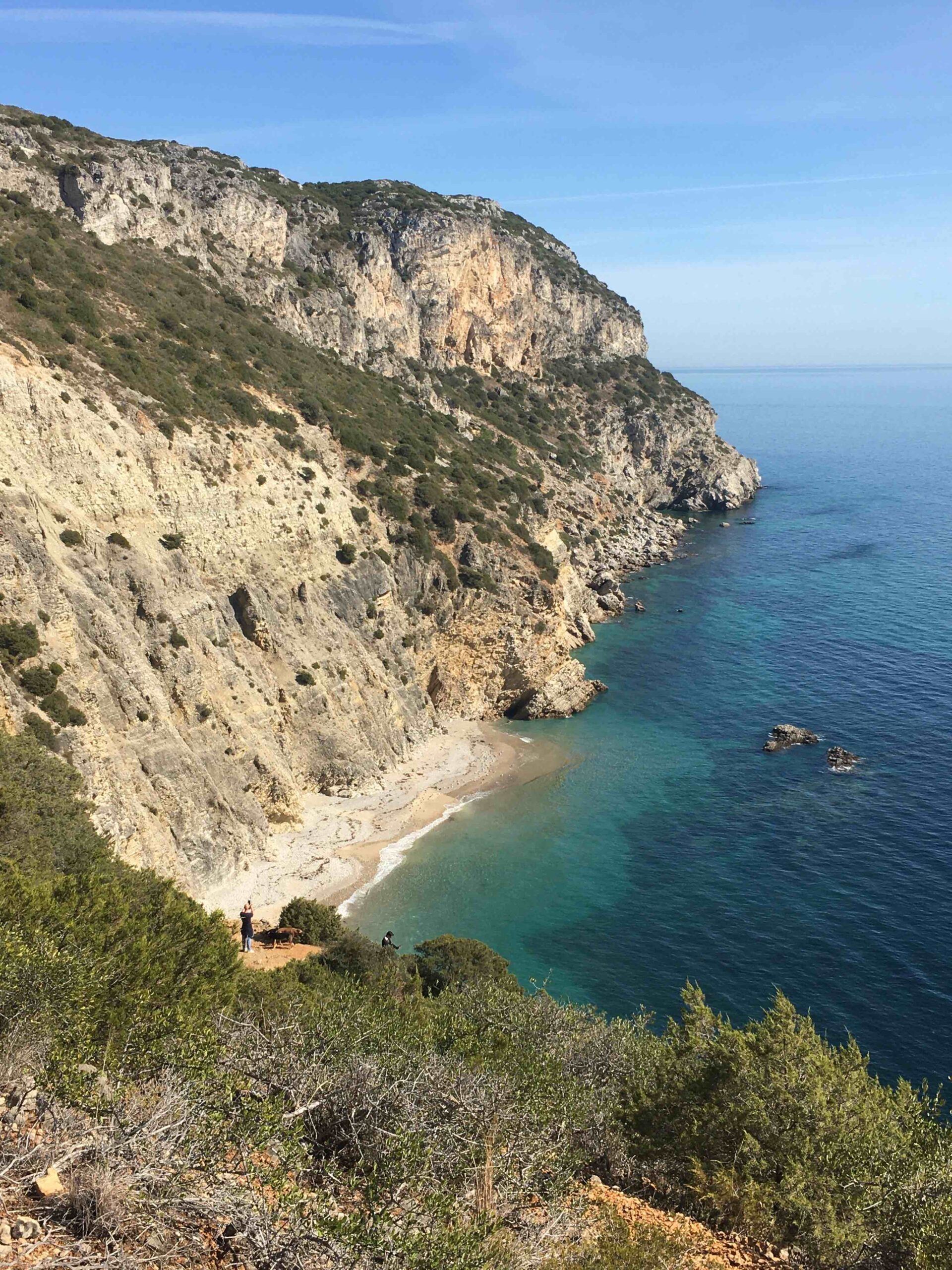
Arrábida trail, just one hour from Lisbon, after wish we had an amazing seafood rice!
It is relevant to note that, in northern Europe, populations also tend to follow an Atlantic diet, which is to be distinguished with the southern European Atlantic diet. While in the north Atlantic (think countries like Iceland, Norway, Denmark, Ireland, United Kingdom, Belgium and The Netherlands) fish is also a major staple, in southern Europe (namely in Portugal and Spain), fish is accompanied by lots more vegetables, which the climate and topography of the Iberian Peninsula are conducive to grow.
Comparably to the Mediterranean diet, the Southern European Atlantic diet also expands beyond the realms of food and focuses on overall lifestyle, including daily physical activity and leisure time in close contact with nature (land or sea).
How Portugal’s geography is responsible for variations in diet: the mainland, the Azores and Madeira
As mentioned above, thanks to its geography, we can clearly identify the prevalence of the Mediterranean diet in certain areas of Portugal, namely in the Algarve region, while other territories are more closely linked to the Atlantic diet. This is the case of northern Portugal, for instance the coastal Minho region which borders Galicia in Spain, but also as we go down the Atlantic coast of Portugal onwards to the Great Lisbon region and further south.
The same basic principles of the Atlantic diet can be observed differently according to regions of the country, whether closer to the coast or not, whether there are other local products available on a given season, or even shaped by other cultures that have been present in a given region (think about the Moorish influence which is more latent towards the south of Portugal, for example). Curiously, even when we’re talking about the same dish, its recipe can be interpreted differently depending where in Portugal we may be (see the illustrative examples of different fish soups at the end of this article).
If there are parts of Portugal which are undeniably connected with the Atlantic ocean, those are the Portuguese archipelagos of Azores and Madeira, both in the Atlantic. The nine islands that make up the Azores are heaven on earth for seafood lovers. Even though the islands are praised for their incredibly high quality pasture-raised beef with PGI status, as well as milk and dairy products (think of the intense DPO São Jorge cheese from the island by the same name), the plethora of seafood species that can be captured around here is remarkable. The same goes for Madeira, where the Atlantic provides in the form of fish, but also is, along with other natural factors, decisive on the climate of the islands making them prone to cultivate certain varieties of fruits and vegetables not commonly found in the Portuguese mainland.
The essence of the Portuguese Atlantic Diet
Fish is one of Portugal’s most important ingredients
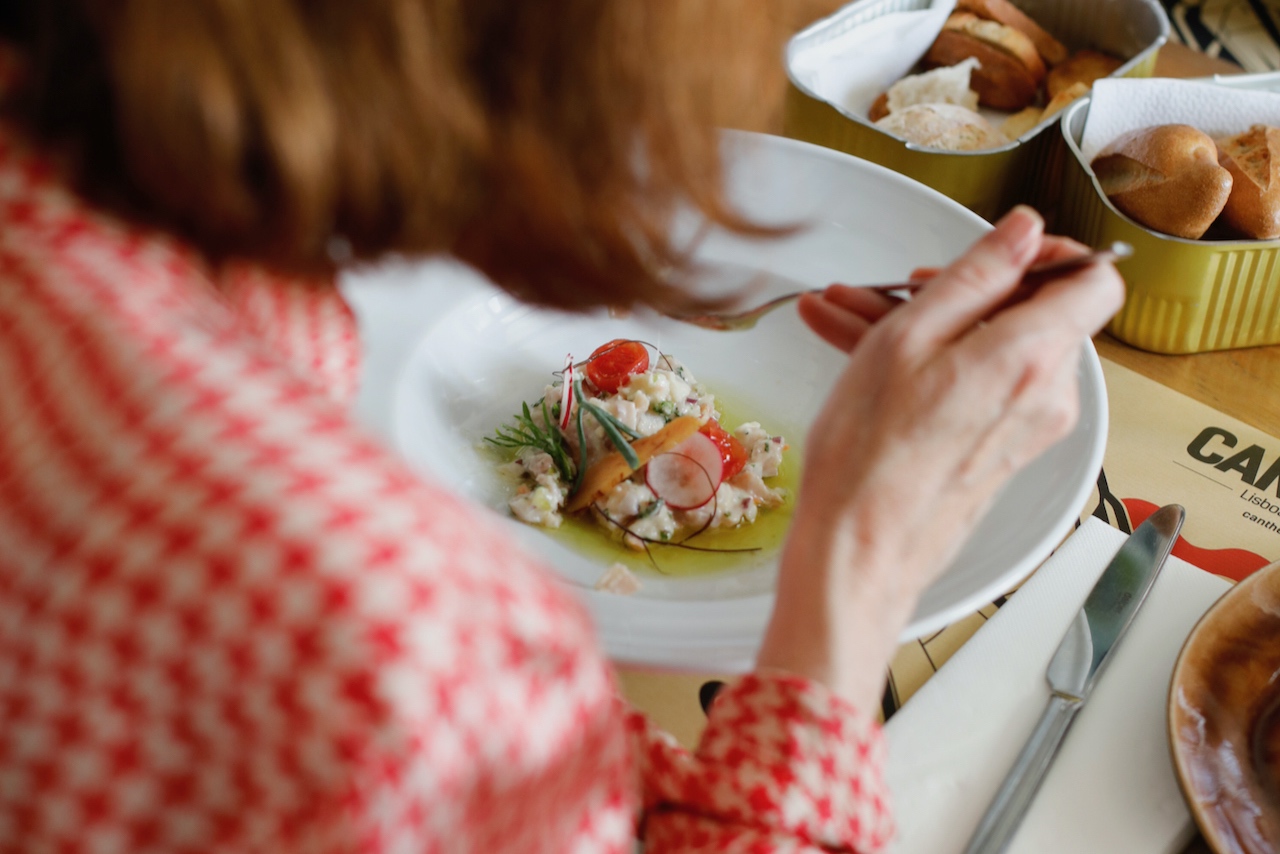 When you travel and eat around Lisbon, or simply look into the repertoire of traditional Portuguese cooking, you’ll notice how relevant seafood is. Many of the recipes of Portuguese typical food include fish, mollusks, crustaceans or shells.
When you travel and eat around Lisbon, or simply look into the repertoire of traditional Portuguese cooking, you’ll notice how relevant seafood is. Many of the recipes of Portuguese typical food include fish, mollusks, crustaceans or shells.
Ever since the days of the Roman Empire, about 2000 years ago, Portugal was one of the main exporters of preserved fish to the entire empire, which covered most of what is now-a-days Europe. This was also the heyday of the production of garum, a pungent fermented fish sauce which was used as a condiment to enhance all sorts of dishes. Even though the art of garum making was mostly lost over the centuries, in recent years, it has been making a come-back thanks to an academic research project. If you’re curious to try garum and eat fish like you’re probably never had before, we’d highly encourage you to join our exclusive Garum and Umami Lisbon Food Tour.
When you think of Portuguese fish dishes, perhaps simple grills over charcoal may come to mind – we may have our obsession with grilled sardines during summer festivals to blame for that! Alternatively, loose rice dishes (like arroz de marisco) or soupy stews with the catch of the day (like caldeirada or cataplana) could also materialize in your imagination. But seafood in Portugal is so much more than this!
Besides fresh fish, our habits also expand to carefully selected tinned seafood and even preservation as a way of developing new flavors of fish which could easily be compared with what’s most traditionally and globally done with meat. During our food experiences in Lisbon, for example, we explore how we can look at fish as if it was meat, not only making the most of the ingredients in terms of flavor and gastronomic pleasure, but also making them a much more sustainable source of animal protein by using most of the creatures.
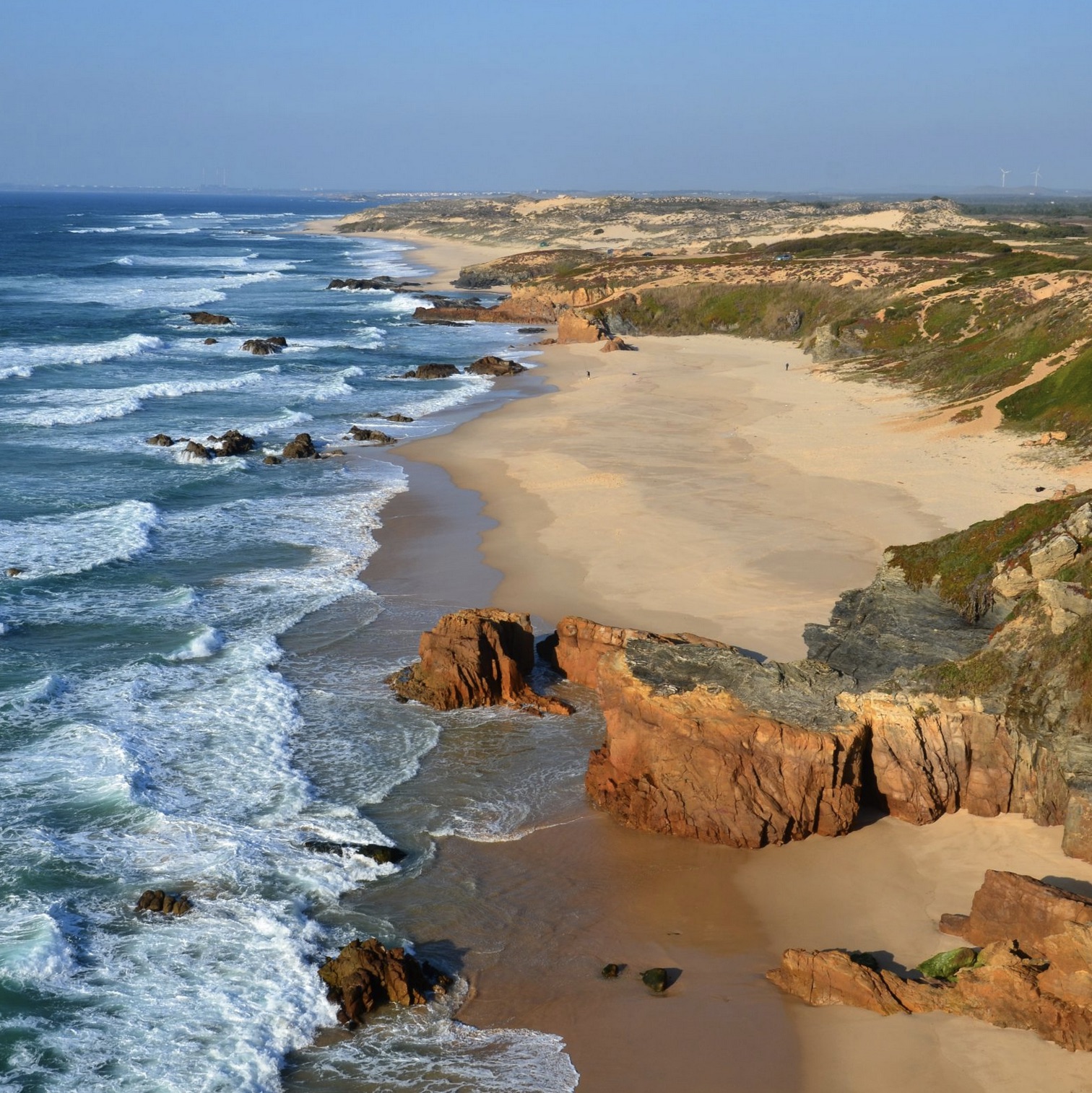
Fisherman trail in Portugal (Costa Vicentina)
If you visit any coastal region of Portugal, you’ll certainly be faced with the national passion for fish, caught directly from our Atlantic shores, but also imported from the northern Atlantic, like it happens with cod, which is brought in fresh to Portugal, and salt cured according to local taste once inside the country. It’s fascinating to think that, beyond geographical reasons, our diet has been tremendously impacted by socio-political factors. When it comes to the Atlantic diet, we can observe that, after the 60s, its eating patterns gained prevalence when compared to the Mediterranean diet which is also present in Portugal but that has been losing relevance over recent decades. During the dictatorial regime led by Salazar (1933–1974) the consumption of fish, namely of salted cod, reached unprecedented highs, not because of natural demand for this product, but because the regime pushed it as a symbol of national identity. Read more about Portugal’s historical links and centuries-old obsession with salt cod here!
If Iceland is Europe’s largest consumer of fish, coming to about a heaping 90 km per person per year, Portugal comes second, adding up to almost 60 km per capita per year. But diversity is key, as we have access to many different species of fish, shellfish, mollusks and crustaceans thanks to the generosity of the Atlantic ocean and, when paired with other land products the soil of the Iberian peninsula is good for growing (produce, cereals, meat and dairy) make for such a rich cuisine!
The diversity of the Portuguese Atlantic diet can be tasted by visiting one of the many fishing villages that exist from the north to the south of Portugal (for example Ericeira, Peniche or Sesimbra near Lisbon) or even walking the Fishermen’s Trail in the Alentejo Atlantic coast. Not only is this one of the most stunning coastal trails in the world, passing by typical fishing towns and dramatic cliffs with phenomenal vistas, all your physical effort can be greatly rewarded by stopping along the way to recharge your energies while eating traditional Portuguese food at small family run businesses which usually have access to the freshest products and fish caught only a few hours before it lands on your plate.
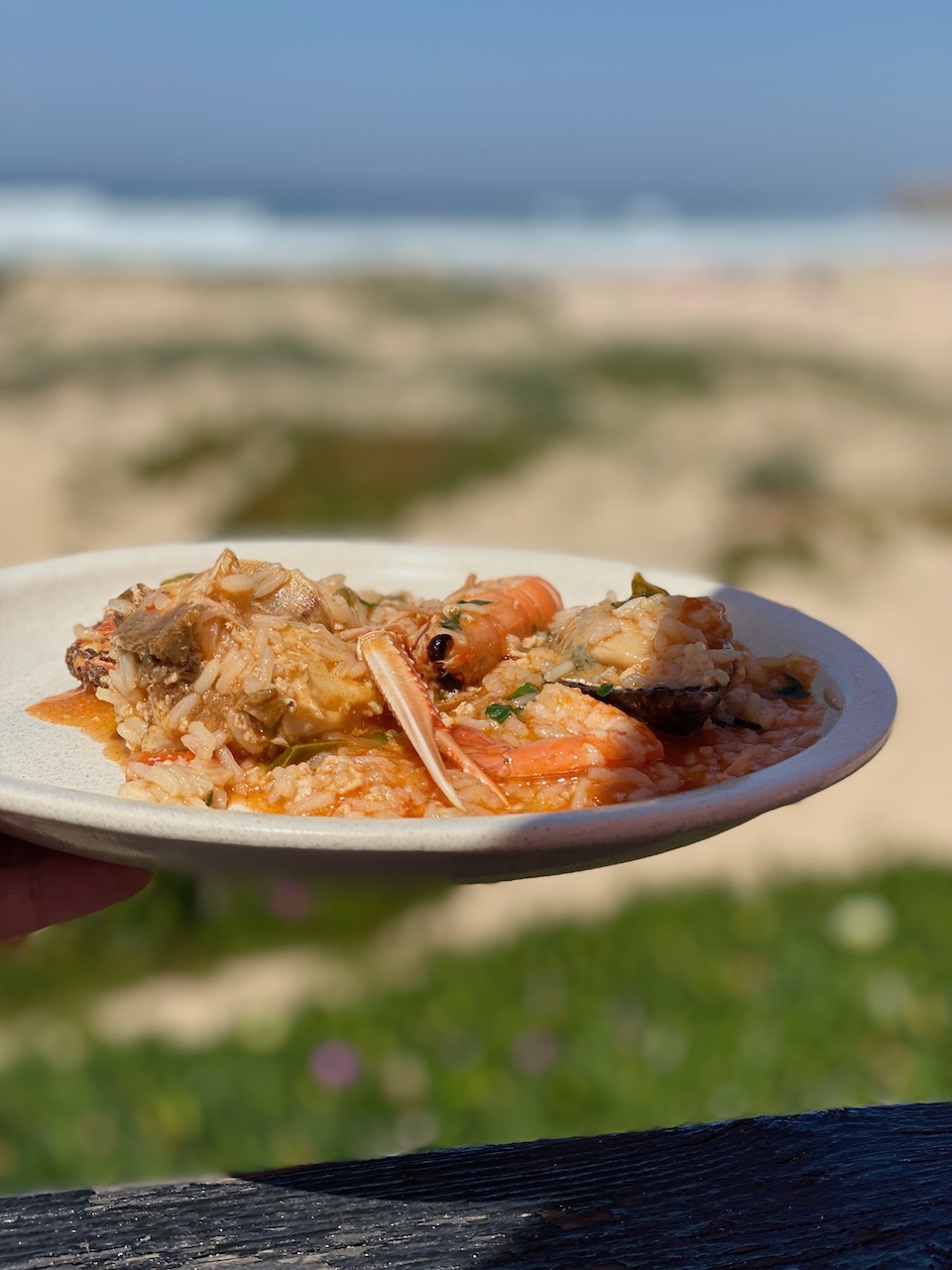
Seafood rice in a secret restaurant in front of the beach, along ‘Fisherman trail’
What are the most relevant dishes that define Portugal’s Atlantic diet?
Portugal’s Atlantic diet is best understood by tasting it. If you wish to savor what the Atlantic diet ultimately boils down to, we suggest looking into specific dishes such as:
- Caldeirada: typical fisherman’s stew, with various pieces of fish according to the catch of the day, swimming in a tomato rich broth with soft potatoes;
- Arroz de marisco: assorted seafood rice (not to be mistaken with drier Spanish paella) but also other comparable rice dishes like arroz de tamboril (monkfish rice) and arroz de lingueirão (razor clam rice);
- Octopus recipes like polvo à lagareiro (roasted with olive oil and garlic) or arroz de polvo (octopus rice);
- Simple grills on the stove-top or over charcoal, featuring fish such as seabream, sardines, seabass, grouper, Azorean tuna, or even mollusks like limpets;
- Shellfish cooked with olive oil and garlic (like clams Bulhão Pato with lemon juice and coriander);
Salted cod dishes are also relevant within the sphere of the Atlantic diet and, thankfully, there’s no shortage of options for you to try, as we popularly say that there are more than 365 cod recipes in Portugal, one for each day of the year!
In any case, you shouldn’t think Portugal’s Atlantic diet only materializes into traditional recipes which have been around for many generations. If you explore Portugal’s contemporary dining scene, in Lisbon or elsewhere, you’ll come across modern and even fine-dining dishes which very well represent the quintessence of this diet. Some of Portugal’s most celebrated chefs today, such as José Avillez, Henrique Sá Pessoa and Pedro Almeida, amongst several others, are doing wonders not only to present intricate dishes which delight dinners, but do so while truly valuing fish as a product which should be handled with skill and respect.
Southern European Atlantic diet vs Mediterranean diet
What is the Mediterranean diet?
Most common foods according to the Mediterranean diet
The Mediterranean sea has greatly contributed to the shared identity countries which border its waters have in common. In fact, historically speaking, the Mediterranean sea was the main point of connection between Southern European countries, which would generally sail for transportation and trading activities.
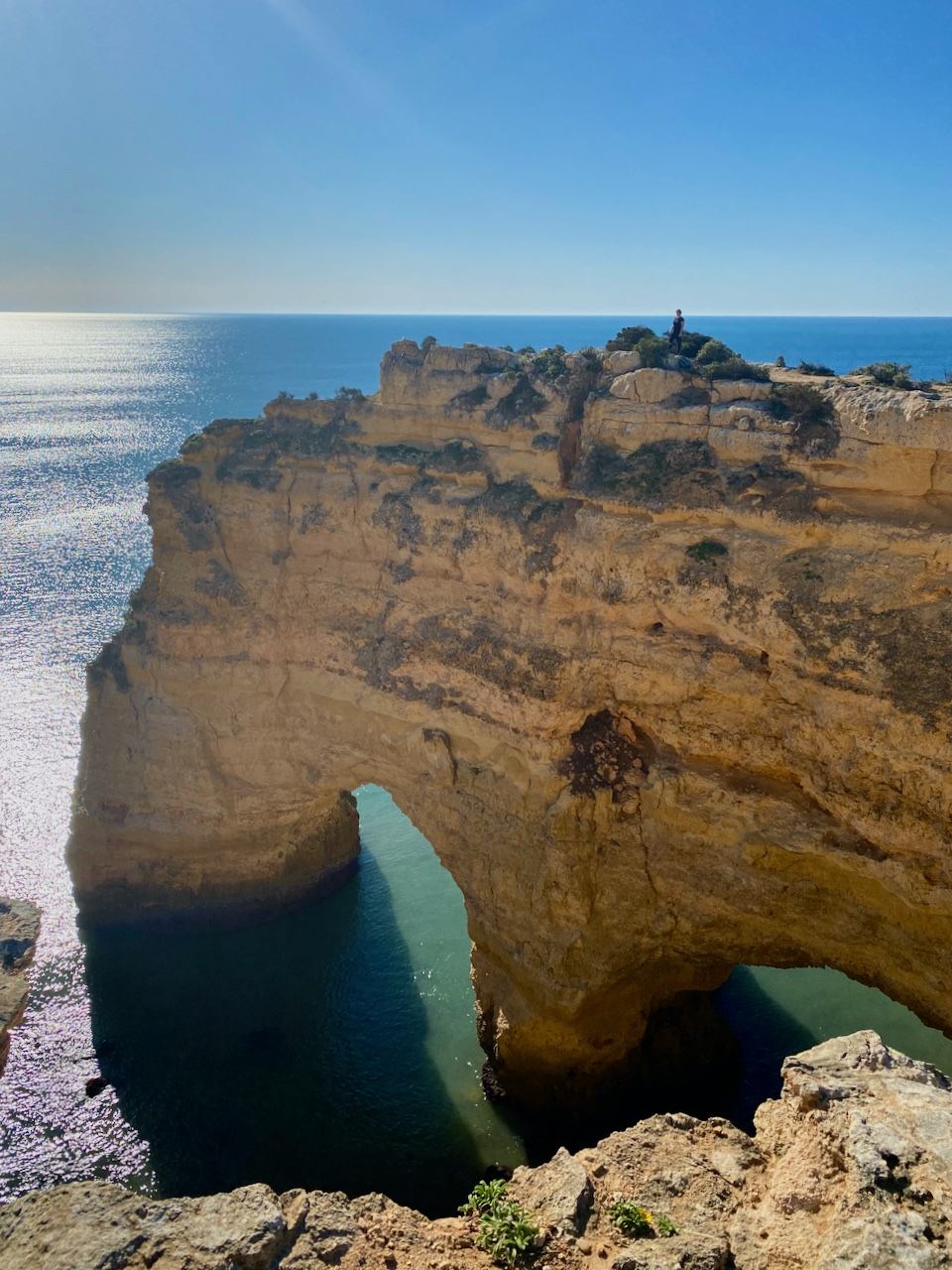
One of the most stunning trails in the Algarve region. Natacha (@atlanticfisherwoman) on top of one of the ‘7 hanging valleys’!
The Portuguese region which is the most connected to the Mediterranean is the bottom south of Portugal, the Algarve, which is in fact the only area of our country which borders the Mediterranean sea, as most of Portugal’s shoreline is connected to the Atlantic ocean. Exploring the gastronomic wonders of the Algarve is a beautiful opportunity to dig deeper into the pillars and essence of the Mediterranean diet. UNESCO has highlighted the southwest Algarvian city of Tavira to represent Portugal in the Mediterranean diet. Eating in and around Tavira you’ll be able to taste incredible dishes which are a materialization of our culinary and more broadly speaking cultural and historical heritage. Historically, the Algarve was home to different kinds of civilizations that left a mark in the Portuguese territory, such as the Phoenicians, Greeks, Romans and Arabs from northern Africa, which precisely ended up coming to Portugal and were connected amongst themselves by the Mediterranean sea. If you visit Portugal during September, don’t miss out on the Mediterranean Diet Fair which the Municipality of Tavira hosts, where not only you’ll be able to taste traditional products, but also attend talks about agricultural practices, natural preservation, health, uses of key Mediterranean ingredients and so much more! Any other time of the year, it’d be a good idea to book yourself for a meal at Restaurante Noélia, where renowned Chef Noélia Jerónimo crafts incredible Algarvian dishes and Mediterranean meals with a lot of soul.
The ethos of the Mediterranean diet focuses not only on food per se, but also habits. When it comes to ingredients, it favors local and seasonal products. We’re mostly talking about vegetables and fruits, but also whole grains, legumes and nuts. According to the principles of the Mediterranean diet, which ended up coming about due to geographical reasons, olive oil is the main source of fat, while meat and dairy intake is fairly low. Fish and leaner meats such as poultry are to be more broadly consumed as animal sources of protein, rather than pork or beef. Mediterranean diet preparations tend to be fairly simple (think lots of soups and stews with no formal recipe, but rather general guidelines passed down from generation to generation), letting the flavor and nutritional profile of the natural ingredients shine through, often being enhanced by fresh herbs and spices. When it comes to beverages, water is the main source of hydration and should be drunk abundantly, while wine is certainly not frowned upon and even encouraged during meals, as long as it is with moderation.
The Iberian Peninsula is one of the most biodiverse places in the whole of Europe, thus has historically provided its inhabitants with lots of nourishing sources of food which, differing according to four well defined seasons of the year, and which are also varied in terms of flavors and nutrients. As such, the Mediterranean diet wasn’t ever planned as such, but naturally came about as topographically and socio-economic factors came together over the centuries.
More than food: the Mediterranean diet is a lifestyle!
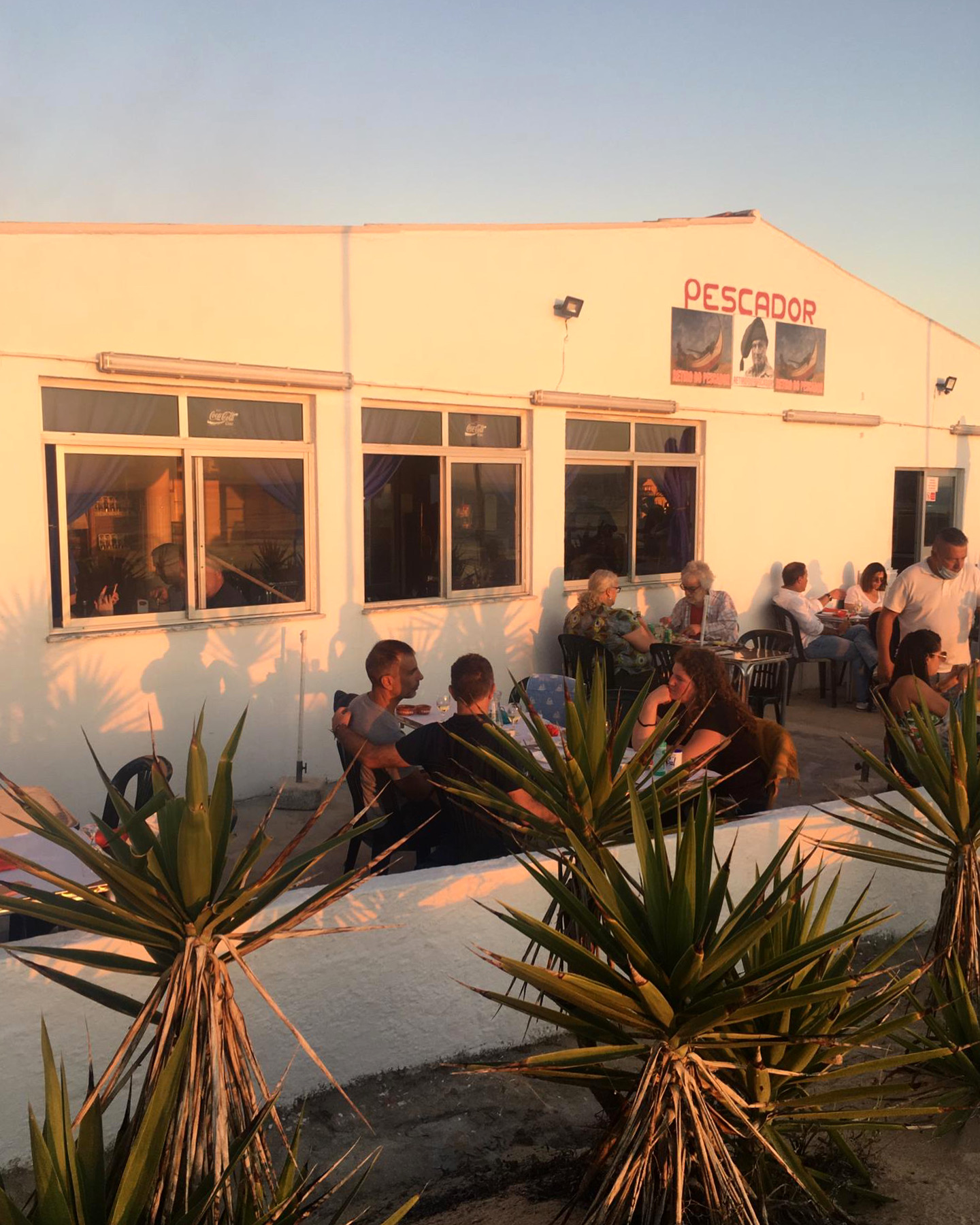
Portuguese lifestyle! Diner with friends.
Socializing around the table is one of the distinctive characteristics of the Mediterranean diet. In Portugal, we often joke that we love eating while talking about food. If you make friends with locals when you visit our country, you’ll see that we don’t mean this in a caricatured way, but quite literally! Not only do we often entertain guests while discussing how we’ve prepared the dishes we’re serving, our friends and family also engage, explaining how they would normally cook the same dish, reminiscing on a fabulous meal they’ve recently had, or even what they’re planning to eat next. Spending quality time with our loved ones, particularly sitting around the table while leisurely enjoying foods and drinks, is part of our Mediterranean lifestyle and of the Mediterranean diet itself.
The Mediterranean diet favors eating slowly and with company. Enjoying your meal while socializing is an essential part of the Mediterranean diet lifestyle! It could be argued that this is a major source of well-being, as it’s been vastly researched that social connections do make people happier.
Physical exercise is also observed within the principles of the Mediterranean diet. Of course, over many centuries, regular physical movement was directly associated with food production in itself, as there were more people making a living from agricultural practices or, at the very least, had some production of vegetables and perhaps even livestock to tend to at home. Now-a-days, when populations increasingly live a more urban lifestyle, this physical movement often translates into quality time spent outdoors when possible, perhaps walking with company or by yourself (even better if this happens after a meal!), and with as much contact with nature as accessible to each person.
It could also be argued that the Mediterranean diet is one of the most sustainable, not only from an environmental point of view (specially when we consider the local nature of ingredients and their seasonality), but also from a social and economic stance, as this diet and lifestyle directly support local farms, producers and even artisans responsible for crafting the traditional vessels for cooking and serving Mediterranean food (such as clay pots).
Is the Atlantic diet better than the Mediterranean diet?
Curiously, even though the Mediterranean diet as a concept encompasses only the Mediterranean regions, it has a lot of similarities with the food and social habits we find across the so-called Blue Zones of the world. These are five different places around the world, which have been first identified in 2004 by Gianni Pes, Michel Poulain and Dan Buettner and vastly studied ever since. The Blue Zones include Okinawa in Japan, Sardinia in Italy, Nicoya in Costa Rica, Icaria in Greece, and Loma Linda in California, USA.
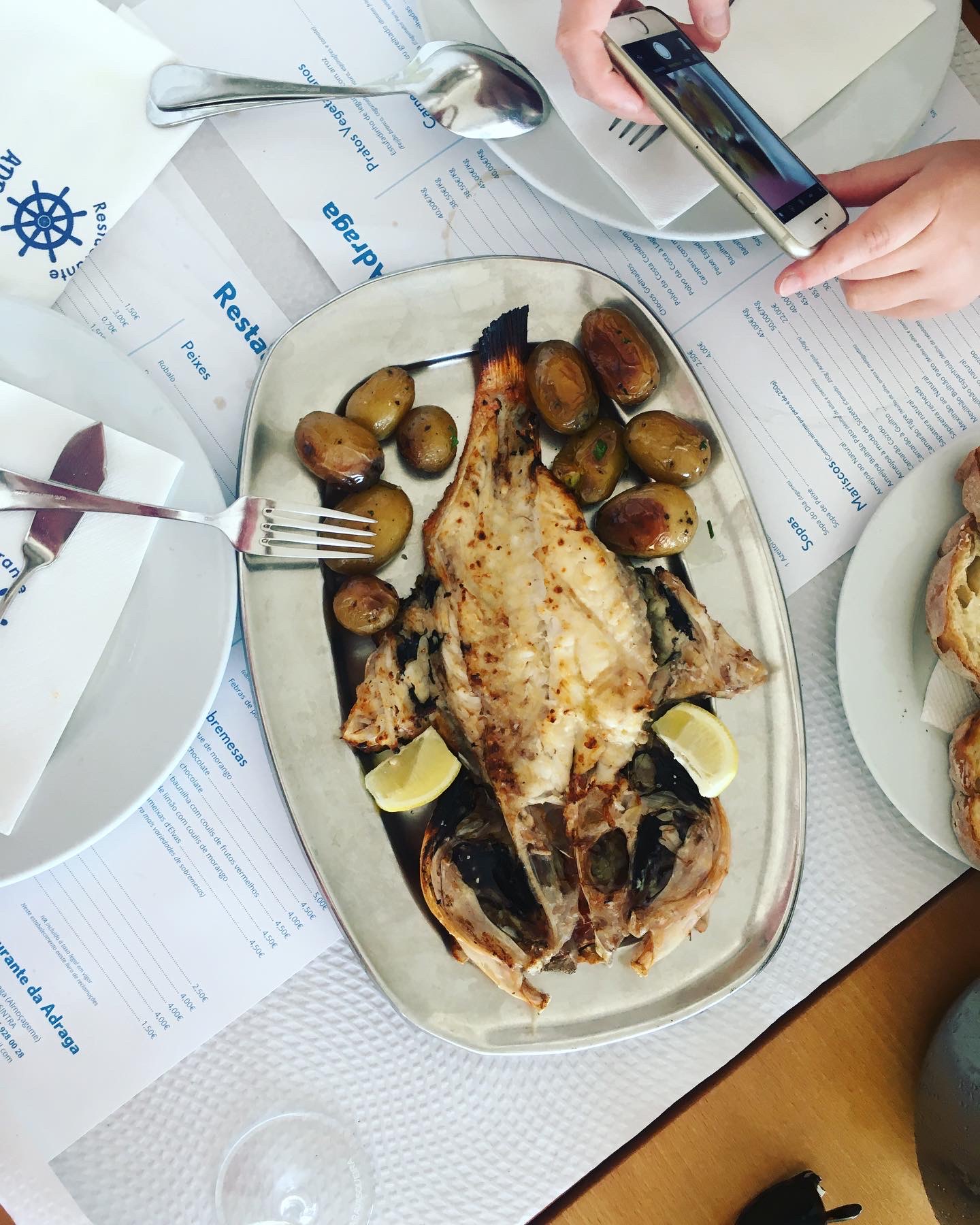
Restaurant with a beautiful beach view in Sintra, with plenty of fresh seafood and a delicious fish soup.
Thanks to its geography, Icaria follows a Mediterranean diet, but every other place mentioned here equally emphasizes the consumption of local and seasonal products, favoring plants and legumes rather than animal products. So what do these places have in common besides food? They have the highest concentration of centenarians in the world, a fact that has been linked to eating habits as well as overall lifestyle, where social connections and regular physical exercise are a daily affair.
Even if the Mediterranean diet has been widely associated with lower risk of heart disease and longer longevity, some specialists argue that the Atlantic diet may be as healthy, if not even more. Both diets share the fact that they are rich in unsaturated fat, thanks to the consumption of olive oil and nuts are natural sources of fat. Even though you may think Portugal uses a lot of salt to season its food, the truth is that both our Mediterranean and Atlantic dishes are still fairly low in salt content, particularly when compared to processed foods. This is all good news but, at the end of the day, what European diet is actually better for you?
Specialists argue that the overall health benefits of both these diets, particularly when it comes to heart related matters, is comparable. Following an Atlantic diet which favors fish much more than meat and dairy can have obvious benefits, particularly because of the intake of omega 3 fatty acids found in fish, which favor cognitive function and play a significant role in the prevention of coronary heart disease. This omega 3 could also be consumed via eating seaweed which is abundant yet not widely used in local cuisines (even though efforts to promote algae consumption can be felt during the last few years), with the exceptions of some seasonal examples in the Azores, where locals have for generations been cooking savory cakes with erva patinha, aka Atkantic nori. Protein intake is also in many cases higher for those following the Atlantic diet versus the Mediterranean one, which is a bonus as long as the sources of protein are leaner fish and meats.
Restaurants in Lisbon where to explore the Atlantic diet
Atlantic diet food tour by Oh! My Cod
Our passion to understand Portugal’s culinary heritage, not only from a gastronomic point of view, but also digging deeper into the geography, history and socio-economics that shape our eating habits, have led us to develop our food and cultural tours in Lisbon and the Azores islands. In all of our experiences you’ll be able to taste examples of the southern European Atlantic diet we follow in Portugal, but in none will it be more obvious and explanatory than during our Garum and Umami Lisbon Food Tour.
Brought to you by a chef and a scientist, this tour consists of a guided gastronomic experience like no other in Lisbon! Not only will you be able to learn more about the ancient Roman tradition of garum fish sauce, you’ll enjoy at least 14 different tastings which showcase the many uses of fish, way beyond the obvious recipes you may have in mind when you picture Portuguese food. For instance, have you ever heard of swordfish bacon, tuna chorizo, fish pastrami or fish foie gras?
We’re positive that even folks who aren’t particularly into seafood will enjoy this slow food experience, to acquire more knowledge about the world of Portuguese seafood, but also to taste impressive creations packed with umami!
Best restaurants for Atlantic dishes in Lisbon
If you’d rather explore some of Portugal’s best Atlantic dishes independently, we would recommend visiting some of the best fish and seafood restaurants in Lisbon:
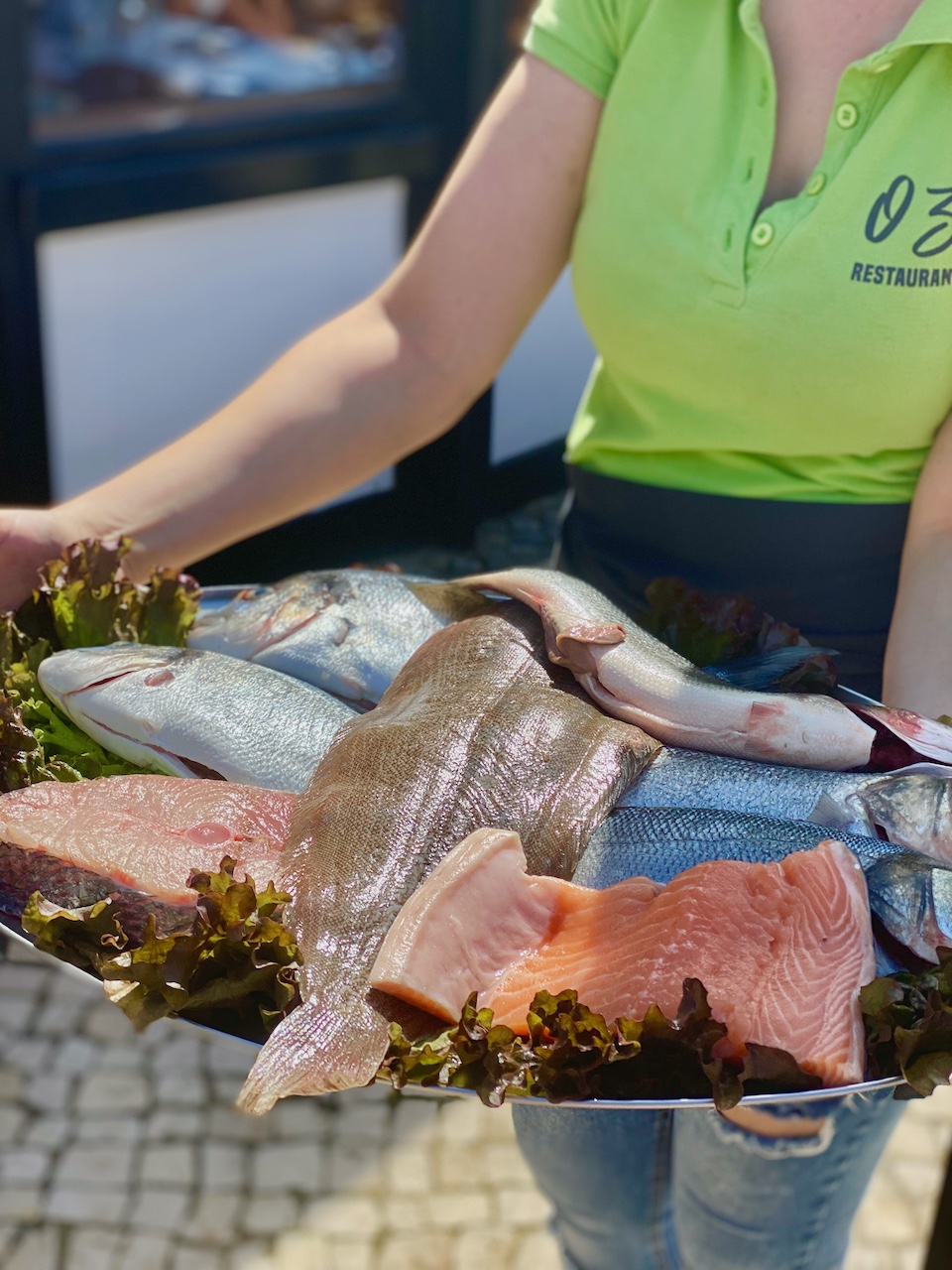
In Portuguese restaurants, it’s common to choose your fish from a plate brought at your table (restaurant at ‘Costa Vicentina’).
Can The Can
For all things preserved fish and seafood “out of the box”
?Praça do Comércio 82 83, 1100-148 Lisbon
Último Porto
To taste the simplicity of Portuguese charcoal-grilled fish
?Rua Gen. Gomes Araújo 1, 1350-352 Lisbon
www.facebook.com/rest.ultimoporto
Solar dos Presuntos
For hearty Portuguese fish recipes
?Rua das Portas de Santo Antão 150, 1150-269 Lisbon
Nune’s Real Marisqueira
For Atlantic seafood at its best
?Rua Bartolomeu Dias 172 E F, 1400-031 Lisbon
Espaço Açores
For seafood dishes from the Azores
?Largo da Boa-Hora à Ajuda 19, 1300-098 Lisbon
Bonus recipes: fish broths from the Azores and mainland Portugal
As mentioned above, traditional recipes of Portuguese food, namely those revolving around seafood which is very characteristic of the southern Europe Atlantic diet, may vary considerably according to each region of the country. To illustrate the similarities but mostly the contrasts, we share with you here two portuguese fish recipes: caldo de peixe, a rich fish broth which is on the limbo between being a soup and a stew (somehow comparable to French bouillabaisse or Spanish suquet de pescado), with fairly big chunks of seafood. The first recipe is caldo de peixe as traditionally prepared in the island of Pico, in the Azores archipelago, where Oh! My Cod organizes exclusive culinary trips, while the second one focuses on how we’d cook a comparable recipe in mainland Portugal, namely in the fishing town of Sesimbra.
Caldo de Peixe do Pico | Pico Island fish broth
Even if Pico is a fairly small island, with around 15,000 inhabitants, there are various ways of making this recipe across its territory. In fact, this recipe is sometimes also known as caldo de peixe à moda dos Açores, denoting that it’s prepared in all nine islands of this Atlantic archipelago. No matter where you are, the most important thing for anyone to achieve a good result is that the fish must be mature, ultra fresh, and various species ought to be included in the pot.
Recipe for 6 people
Preparation time: about 3 hours (preparing, cooking and making the sauce)
Level of difficulty: easy
Recommended: white wine from Pico, for example ETNOM, by local producer Cátia Laranjo
Ingredients
For the broth:
2 kg of various types of fish (white seabream, red seabream, bicuda and grouper are very good options!)
3 tomatoes
4 garlic cloves
1 large onion
parsley
home baked bread
salt to taste
For the sauce:
a handful of chopped parsley
3 leeks
3 tablespoons of white wine vinegar
4 tablespoons of good wine, red or white
1 teaspoon of saffron
water
Method:
- Prepare the fish by cutting it into thick steaks. Clean the tomatoes, remove the skin and seeds, and cut them into quarters. Cut the onion into segments and the leeks into slices.
- In a wide pan, place enough water to cook the fish and to make the broth: add the onion, leeks, tomatoes and salt (do not add the salt to the fish).
- Allow to boil until the onion and the tomatoes are cooked. Only then is the fish added, taking care to cook it and not to crumble it into pieces. When it is done, but still firm, turn off the heat and add a sprig of parsley. Meanwhile, start making the sauce.
- Parsley sauce for the fish: in a mortar place the salt, garlic, cloves and chopped parsley. Grind everything very well together.
- Pour the sauce into a bowl into which you’ll also add vinegar, wine and water until the quantity is sufficient to marinate the fish, as well as the potatoes that are served with it.
- Place the fish onto a serving platter and season with the sauce you have prepared following the steps above.
- Cut slices of bread and place them inside a bowl. Pour the sauce over them, with all the ingredients from the boil (tomato, onion, leeks) but in such a way as not to overly soak them. Decorate with little parsley sprigs.
Tips and tricks
The broth is usually drunk from little clay bowls but, for this, it must be drained.
Serve the dish with boiled potatoes and cornbread, bolo de milho, as traditionally done in Pico.
Sopa do mar à moda de Sesimbra | Sesimbra style fish soup
Seafood is such an integral part of the identity of the city of Sesimbra, on the south bank of the Tagus river which flows along Lisbon, that this fishing town even holds an annual gastronomic event, Quinzena Gastronómica das Sopas do Mar, entirely dedicated to seafood soups. Following this recipe you’ll be able to observe how the basic idea of this recipe is the same as the one we have shared above from Pico, in the Azores, while indeed including key differences, namely on the types of seafood used and how it is served. This speaks of the regional adaptations of the Atlantic diet, shaped by flavor preferences but, most of all, by the proximity to the ocean and the availability of fresh ingredients.
Recipe for 6 people
Preparation time: about 50 minutes (preparation and cooking time)
Level of difficulty: easy
Recommended: white wine from the Setúbal wine region, such as those using the Portuguese grape varietal Fernão Pires. Bacalhôa brand is a good option.
Ingredients
1.250 kg fish of your choice
1 kg shellfish (such as clams, cockles and/or mussels)
350 g prawns
2 onions
2 ripe tomatoes
4 garlic cloves
1 green pepper
a handful of fresh parsley, cilantro and mint
1 tsp sweet paprika
1 bay leaf
Olive oil
Method:
- Wash the mussels, cockles and clams in running water. Leave them to soak in salted water and drain well after 1 hour.
- Cook the fish in water seasoned with salt. Remove the fish and cook the shrimp in the same water.
- Cover the bottom of a pan with olive oil and sauté the thinly chopped onion and garlic.
- Add the clean and chopped tomato, the bay leaf and the fresh herbs roughly chopped.
- When the sauteed ingredients are cooked all the way though, add the broth used to cook the fish (strain beforehand to obtain a clear broth).
- Add the pepper, cleaned and chopped into small pieces, paprika, mussels, cockles and clams. Cook for a few minutes and add the peeled prawns.
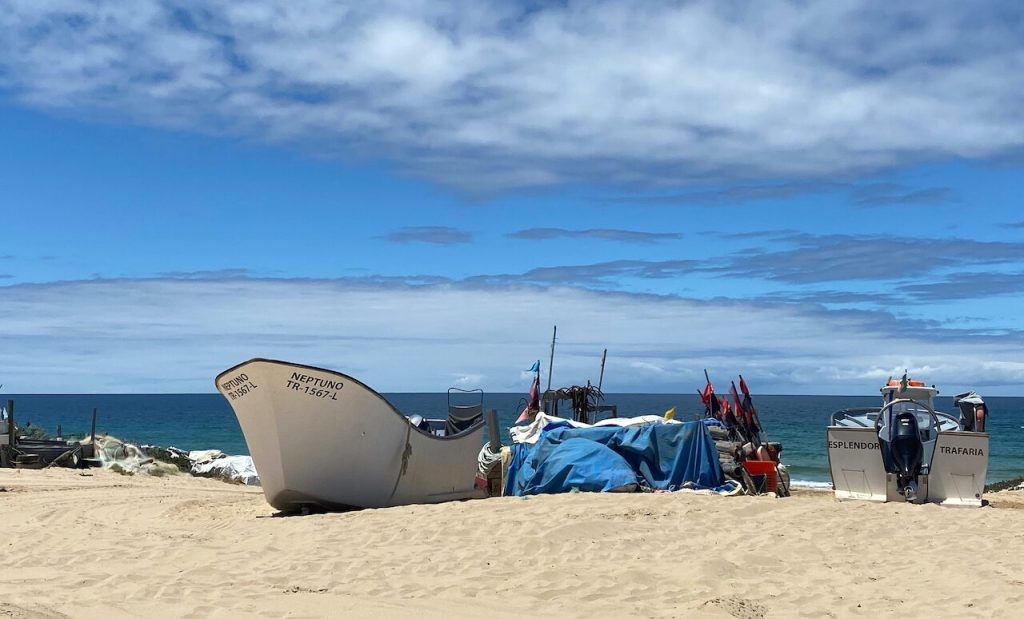
Fishermen village at one hour from Lisbon.
Article by :
Zara Quiroga (freelance food writer and food & cultural leader at Oh! My Cod Pico Trips)
Photos by:
Sílvia Olivença (anthropologist and food guide/CEO at Oh! My Cod Ethnographic Food Tours & Trips)
Want to more about Portuguese cuisine?
Pico Wine: one of the world’s most unique wine regions (Genesis – Part I)
Alentejo and Algarve: culinary traditions of the South of Portugal
10 Portuguese Codfish recipes step-by-step
Minho, Douro and Trás-os-Montes: the cuisines of Northern Portugal (includes Porto!)
